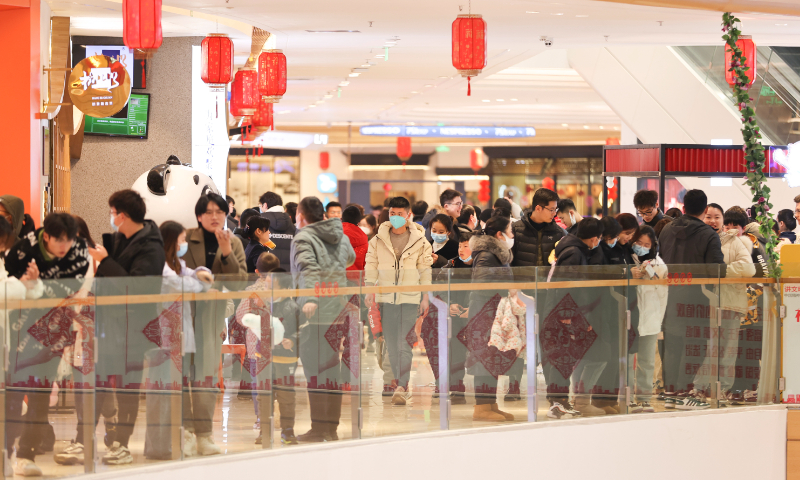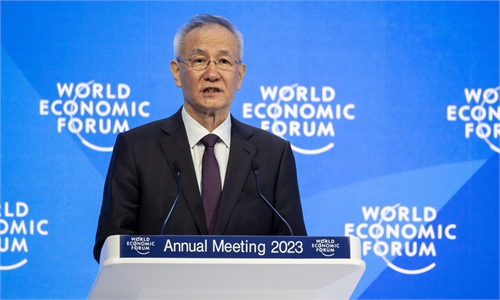China's economic vitality underpinned by 3-year dynamic COVID response, a divergence from chaos in the US, Europe
Three-year dynamic COVID response proven to maximize social economic benefits with minimum costs

Residents are seen at a shopping mall in Lianyungang, East China's Jiangsu Province, on January 23, 2023 during the Spring Festival holidays. Photo: VCG
The once-a-year Spring Festival, China's most important traditional holiday, had just ended with a stunning rebound in consumer spending. Shopping malls, restaurants were thronging with shoppers, and overseas travelling companies across the world from Thailand, Singapore to Indonesia were also eagerly welcoming the return of Chinese travelers with their biggest smiles.
The world's second-largest economy has been shrugging off the clouds posted by the epidemic and is now firing on all cylinders in 2023, a momentum which economists said is underpinned by the country's three-year dynamic COVID response that has proven to have maximized social economic benefits with minimum costs, economists said.
The vibrancy and resilience displayed by the Chinese economy is also a divergence from the chaos in the US and European countries over the last three years, where flip-flop monetary policies have fueled global runaway inflation, dented growth prospects and pushed the world grapple with recession fears. In contrast, China has played the key role as both the locomotive and stabilizer in global economy over the last three years, observers noted.
Over the past three years, China has effectively coped with about five waves of global COVID variant outbreaks, drastically reduced deaths and severe cases, which is a hard-won achievement for a country home to 1.4 billion people.
Meanwhile, the Chinese economy grew at 4.5 percent on average over the last three years, significantly higher than the global average of 1.8 percent and leading major economies. The US, eurozone, and Japan recorded an average growth rate of 1.6 percent, 0.7 percent and -0.3 percent, respectively, during the same period, according to the Global Times' calculation from data released by the World Bank and IMF.
A key to China's response to COVID-19 in the past three years is good coordination of epidemic prevention and social economic development, which serves as the fundamentals for China to withstand multiple challenges while global economy was taking a hit from the pandemic. It is not an "either-or choice" at all, economists said. It also set an example on how a responsible major power should act for the well-being of the world.
A review of the past three years
Back to 2020 the first year of epidemic outbreak, China's economy expanded 2.2 percent, the only major economy in the world to eke out an expansion, while the US, eurozone, and Japan, whose economic fundamentals had been hammered by the voracious virus onslaught, contracted 2.8 percent, 6.1 percent, and 4.3 percent, respectively.
The year of 2021 has witnessed the impressive 8.4 percent rise of Chinese economy. In the global sphere, the US, eurozone, and Japanese economy also performed well, expanding 5.9 percent, 5.3 percent, and 2.2 percent, respectively, mostly boasted by the US-led flood-like stimulus that year.
In 2022, against the backdrop of US Fed's abrupt monetary policy tightening, China's cost-effective COVID response has sustained its GDP to climb 3 percent year-on-year, topping above the 120-trillion-yuan mark for the first time. The reading outshines most other major economies including the US' 2.1 percent and Japan, which is forecasted to grow 1.2 percent based on the World Bank's projection.
While China has been the de facto stabilizer of the global economy for the past three years, some developed economies led by the US have dragged the world economy into chaos with persistent inflation, and crippling interest rates as a penalty for their inappropriate response to the COVID, Chen Jia, an independent economist told the Global Times.
"The inflation issues among the developed markets had loomed in 2020, but the efforts to remedy such problem were delayed by the onset of the pandemic, and instead policymakers increased stimulus in 2020, and adopted aggressive interest rate hikes in 2021," Chen noted.
Then in 2022, the US' abrupt shift of monetary policy has not only led to the polarization of global monetary policies, aggravated the chaos of the global financial market and the global trade, but also put US allies including the UK, Germany, Japan, South Korea into acute domestic inflation and trade deficits, Chen said.
China's CPI only rose 1.8 percent when averaged over the last three years, mirroring a stable price operation that dwarfs decades-high inflation in developed economies. In the last three years, the US and eurozone's CPI jumped 4.6 percent and 3.7 percent on average, and reached a staggering 8 percent and 8.4 percent in 2022.
Contribution to the world
Over the past three years, there has been no shortage of evidence underscoring how Chinese impulses injected momentum into global development, and played the role of both an engine and a stabilizer to the world.
"Chinese manufacturing has played a very important role in the global pandemic response, and stabilizing industrial and supply chains have been a prioritized effort on the part of the Chinese government since the onset of the epidemic," Wu Jinduo, head of fixed income at the research institute of Great Wall Securities, told the Global Times.
In 2020 and 2021, when the global supply chain was paralyzed by the pandemic, it was China, the world's largest factory that churned out products and shipped everything from medical supplies to work-at-home appliances to meet the daily needs of consumers around the world. And last year, when Washington's aggressive interest rate hikes jolted the market, affordable "Made in China" products were the key factor in reining in global inflation.
Even for the US, the main advocate of supply chain decoupling from China, its companies such as Tesla still benefited from the stability of China's supply chains, analysts said.
In 2021, China's economic aggregate accounted for 18.5 percent of the world's total after currency translation based on average annual exchange rates. In 2022, China accounted for 18.58 percent of global economy in PPP terms, according to IMF.
Economists have all voiced confidence that as the Chinese economy is on track for an inevitable path to post-COVID-19 recovery, it will continue to be one of the top growth engines for the global economy in 2023.
IMF Managing Director Kristalina Georgieva said in that China is "very likely the single most important factor for global growth in 2023."


